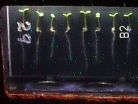HOUSTON, TX, November 29, 2012 (Press-News.org) Why is NASA conducting plant research aboard the International Space Station? Because during future long-duration missions, life in space may depend on it.
The ability of plants to provide a source of food and recycle carbon dioxide into breathable oxygen may prove critical for astronauts who will live in space for months at a time. In addition, plants provide a sense of well-being. At the McMurdo Station for research in Antarctica -- a site that in the dead of winter resembles the space station in its isolation, cramped quarters, and hostile environment -- the most sought after section of the habitat is the greenhouse.
NASA and the European Space Agency, or ESA, are studying how plants adapt to micro- and low-gravity environments in a series of experiments designed to determine the ability of vegetation to provide a complete, sustainable, dependable and economical means for human life support in space. As researchers continue to gain new knowledge of how plants grow and develop at a molecular level, this insight also may lead to significant advances in agriculture production on Earth.
Plant biology experiments on the space station using the European Modular Cultivation System, or EMCS, allow scientists to investigate plant growth and the processes within their cells to understand how plant life responds to conditions in space. Researchers currently are planning three new plant growth investigations specifically designed to examine the growth of seedlings in microgravity using this facility.
Combining the proposals of NASA Principal Investigator John Z. Kiss, and ESA Principal Investigator Javier Medina, the Seedling Growth investigation will continue at the space station for a series of experiments: Seedling Growth 1, 2 and 3 in 2013, 2014 and 2015 respectively. The results of these experiments will help researchers understand how plants sense and respond to the space environment.
Once aboard the space station, astronauts will conduct experiments to examine the seedlings' cultivation and stimulation under controlled temperature, atmosphere composition, limited water supply, illumination and acceleration conditions using centrifuges. Because the station crew is key to the success of the experiments, crew members will receive significant training, including on-board computer video instruction.
Thus far, NASA's Ames Research Center, Moffett Field, Calif., has completed three experiments using the EMCS. The 2006 study called Root Phototropism, or Tropi, used Thale cress (Arabidopsis thaliana) seeds from the mustard family to investigate how plant roots respond to varying levels of light and gravity. Using a rotating centrifuge, Kiss designed the experiment to expose the plants to different gravity conditions.
In 2010, the Tropi-2 experiment expanded on the knowledge gained from the first Tropi investigation. Collectively, the two studies demonstrated how red and blue light affects plant growth differently at varied levels of gravity. With this information, researchers now know that they can optimize plant root and shoot growth in space by fine-tuning the plants' exposure to light.
Most recently, the Plant Signaling space experiment, led by Principal Investigator Imara Perera, research associate professor at North Carolina State University, Raleigh, N. C., studied the roots and shoots of wild type and genetically modified Thale cress plant seedlings in microgravity and 1g -- a simulation of Earth's gravity. Images of the seedlings were sent to Earth before astronauts harvested and preserved the seedlings for post-flight analysis. The frozen plants are scheduled to return to Earth in 2013 aboard a SpaceX Dragon capsule.
The analysis of these data will lead to an understanding of the molecular mechanisms plants use to sense and respond to changes in their environment. Insights gained from this study will help scientists identify plants that are better able to withstand long duration spaceflight and microgravity conditions.
Unique Environments Demand Specialized Equipment
Provided by ESA, the EMCS consists of a holding structure filling four station lockers and includes an incubator with two centrifuges. Two to four Ames-developed Experiment Containers, or ECs, can mount to each of the two centrifuge rotors to allow scientists to perform experiments at various g-levels up to twice Earth's gravity, or 2g.
The EMCS design enables control of temperature, humidity, oxygen and carbon dioxide. Equipped with white and infrared lights, EMCS also can control g-level simulation and water to perform experiments with biological samples. Video observation, imaging, data handling and command systems allow for control of the experiments inside the ECs. The ECs have specialized systems to study cell biology, small aquatic animals, roundworms, fruit flies and plants.
NASA's Ames Research Center worked closely with ESA to develop specific experimental units designed to grow plant seedlings, particularly Thale Cress, as well as other plant species. The hardware has performed flawlessly in supporting the Tropi-1, Tropi-2 and Plant Signaling experiments and will be used in the upcoming Seedling Growth study.
For the latest news about research being done on the International Space Station, please visit:
http://www.nasa.gov/mission_pages/station/research/news.html
For more information on past, ongoing, and future ISS research activities, including research results and publications, please visit:
http://www.nasa.gov/mission_pages/station/research/index.html
If you are interested in subscribing to updates from the ISS Program Science Office, please visit:
https://lists.nasa.gov/mailman/listinfo/iss-program-science-group
For more information about the International Space Station, visit:
http://www.nasa.gov/station
For information about NASA and agency programs, visit:
http://www.nasa.gov
Why Study Plants in Space?
RELEASE: JR12-023
2012-11-29
ELSE PRESS RELEASES FROM THIS DATE:
Offshore Group Podcast Examines U.S.-Mexico Bilateral Aviation Safety Agreement
2012-11-29
The Tucson, Arizona -based Offshore Group recently dialogued with Alberto Gayou, the principal attorney at the Ciudad Juarez-headquartered Mexican law firm LexCorp Abogados, S.C. on the topic of the Bilateral Aviation Safety Agreement, or BASA, that exists between the United States and Mexico
During the course of the conversation, Gayou clearly explains the ways in which the accord will concretely affect the growth of the aerospace industry in Mexico for the next decade or more.
According to Gayou, "It (the BASA) is an accord that is of critical importance. ...
TV 3.0 is Finally Coming, Cable and Satellite in Rearview Mirror
2012-11-29
Next week, FreeCast, Inc - a leader in digital TV distribution (DTVD) with the largest virtual guide of popular television, movies, and music content sources - will be unveiling a partnership with "As Seen on TV" DRTV giants Telebrands Corp that is expected to offer consumers an unmatched 10,000+ channels and decisive alternative to traditional cable and satellite offers over the Internet.
The product, RabbitTV, will deploy a unique yet simple distribution model to deliver digital media on a more massive scale than current set-top boxes (Roku, Boxee, Apple ...
Plackers(R) Gives the Gift of Healthy Smiles
2012-11-29
In the spirit of holiday giving, Plackers, a leading brand of oral care products, has donated more than 75,000 of its popular Micro Mint disposable flossers for families staying at Ronald McDonald Houses in Texas, California, Louisiana and Missouri.
Through its Ronald McDonald House(R) programs, Ronald McDonald House Charities (RMHC(R)) provides comfort, compassion and vital resources in a home-like environment for families with critically ill or injured children traveling to receive necessary care. Donations like these from Plackers aid in the mission of RMHC by offering ...
The Chamber Orchestra of Philadelphia Lifetime Achievement Award Gala Honoring Burt Bacharach
2012-11-29
The Chamber Orchestra of Philadelphia, a founding resident company of The Kimmel Center for the Performing Arts, will host its Lifetime Achievement Award Gala on Saturday, May 4, 2013 at 6 PM at The Westin Philadelphia. This year's Gala honors one of music's greatest contributors - Burt Bacharach. The event is black tie.
The evening's event will include the presentation of the prestigious Annual Chamber Orchestra Lifetime Achievement Award to Mr. Bacharach with a mini-concert including surprise musical guests, a cocktail hour, a three-course sit-down dinner, dancing ...
NIH study suggests immune system could play a central role in AMD
2012-11-28
Changes in how genes in the immune system function may result in age-related macular degeneration (AMD), the leading cause of visual impairment in older adults, based on preliminary research conducted by National Institutes of Health (NIH) investigators.
"Our findings are epigenetic in nature, meaning that the underlying DNA is normal but gene expression has been modified, likely by environmental factors, in an adverse way," said Dr. Robert Nussenblatt, chief of the National Eye Institute (NEI) Laboratory of Immunology. Environmental factors associated with AMD include ...
Research from ASCO'S Quality Care Symposium shows advances and challenges in improving the quality of cancer care
2012-11-28
ALEXANDRIA, Va. – New studies released today reveal important advances in cancer care quality measurement, physician adherence to quality standards, and end-of-life care, while highlighting the overuse of contralateral prophylactic mastectomy. The studies were released in a presscast today in advance of ASCO's inaugural 2012 Quality Care Symposium. The Symposium will take place November 30 – December 1, 2012, at the Manchester Grand Hyatt in San Diego.
Four major studies were highlighted in today's presscast:
Study finds that most preventive double mastectomies occur ...
Fish ear bones point to climate impacts
2012-11-28
Scientists believe that fish ear bones and their distinctive growth rings can offer clues to the likely impacts of climate change in aquatic environments.
The earbones, or 'otoliths', help fish to detect movement and to orient themselves in the water. Otoliths set down annual growth rings that can be measured and counted to estimate the age and growth rates of fish.
"Otoliths can form the basis of new techniques for modelling fish growth, productivity and distribution in future environments," said Dr John Morrongiello of CSIRO's Wealth from Oceans Flagship, lead author ...
4 is the 'magic' number
2012-11-28
According to psychological lore, when it comes to items of information the mind can cope with before confusion sets in, the "magic" number is seven.
But a new analysis by a leading Australian professor of psychiatry challenges this long-held view, suggesting the number might actually be four.
In 1956, American psychologist George Miller published a paper in the influential journal Psychological Review arguing the mind could cope with a maximum of only seven chunks of information.
The paper, "The Magical Number Seven, Plus or Minus Two. Some Limits on Our Capacity ...
Biggest black hole blast discovered
2012-11-28
Quasars are the intensely luminous centres of distant galaxies that are powered by huge black holes. This new study has looked at one of these energetic objects – known as SDSS J1106+1939 – in great detail, using the X-shooter instrument on ESO's VLT at the Paranal Observatory in Chile [1]. Although black holes are noted for pulling material in, most quasars also accelerate some of the material around them and eject it at high speed.
"We have discovered the most energetic quasar outflow known to date. The rate that energy is carried away by this huge mass of material ...
Potentially toxic flame retardants found in many US couches
2012-11-28
DURHAM, N.C. -- More than half of all couches tested in a Duke University-led study contained potentially toxic or untested chemical flame retardants that may pose risks to human health.
Among the chemicals detected was "Tris," a chlorinated flame retardant that is considered a probable human carcinogen based on animal studies.
"Tris was phased out from use in baby pajamas back in 1977 because of its health risks, but it still showed up in 41 percent of the couch foam samples we tested," said Heather Stapleton, associate professor of environmental chemistry at ...
LAST 30 PRESS RELEASES:
American College of Cardiology comments on new dietary guidelines for Americans
American Society of Gene & Cell Therapy and Orphan Therapeutics Accelerator partner to advance and commercialize promising rare disease treatments
One in 14 patients having day case surgery have new or worse chronic pain 3 months after their operation
New study highlights link between eviction rates and gun violence
Heatwaves heat up soil but not toxin levels in rice, study finds
Digital modeling reveals where construction carbon emissions really come from
Turning farm waste into water filters
New study shows how the spleen helps the immune system accept a transplant
New Mayo Clinic study advances personalized prostate cancer education with an EHR-integrated AI agent
Researchers identify novel therapeutic target to improve recovery after nerve injury
Microbes in breast milk help populate infant gut microbiomes
Reprogramming immunity to rewrite the story of Type 1 diabetes
New tool narrows the search for ideal material structures
Artificial saliva containing sugarcane protein helps protect the teeth of patients with head and neck cancer
Understanding the role of linear ubiquitination in T-tubule biogenesis
Researchers identify urban atmosphere as primary reservoir of microplastics
World’s oldest arrow poison – 60,000-year-old traces reveal early advanced hunting techniques
Bristol scientists discover early sponges were soft
New study uncovers how rice viruses manipulate plant defenses to protect insect vectors
NSF–DOE Vera C. Rubin Observatory spots record-breaking asteroid in pre-survey observations
Ribosomal engineering creates “super-probiotic” bacteria
This self-powered eye tracker harnesses energy from blinking and is as comfortable as everyday glasses
Adverse prenatal exposures linked to higher rates of mental health issues, brain changes in adolescents
Restoring mitochondria shows promise for treating chronic nerve pain
Nature study identifies a molecular switch that controls transitions between single-celled and multicellular forms
USU chemists' CRISPR discovery could lead to single diagnostic test for COVID, flu, RSV
Early hominins from Morocco reveal an African lineage near the root of Homo sapiens
Small chimps, big risks: What chimps show us about our own behavior
We finally know how the most common types of planets are created
Thirty-year risk of cardiovascular disease among healthy women according to clinical thresholds of lipoprotein(a)
[Press-News.org] Why Study Plants in Space?RELEASE: JR12-023






